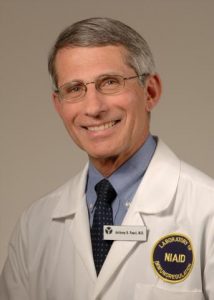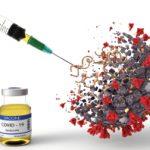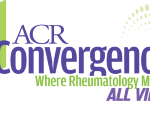ACR CONVERGENCE 2020—At the ACR’s fully virtual annual meeting on Saturday, Nov. 7, Anthony S. Fauci, MD, director of the National Institute of Allergy and Infectious Diseases (NIAID) since 1984, delivered a special lecture on COVID-19, from virology to therapy to vaccine development.
Novel Coronavirus, Familiar Vectors
When Chinese physicians first reported infections by what appeared to be a novel coronavirus in December 2019, infectious disease experts drew on decades of experience with coronaviruses, including those that cause severe acute respiratory syndrome (SARS), Middle East respiratory syndrome (MERS) and many common colds, said Dr. Fauci.1
“Here we are now with a global pandemic of historic proportions the likes of which we have not seen in the last 102 years. We are now currently close to 50 million cases worldwide. In the United States, we have been hit the hardest of any other country,” he said. As of the first week of November, more than 230,000 deaths from COVID-19 were reported in the U.S., according to the Centers for Disease Control and Prevention (CDC).
Dr. Fauci compared seven-day rolling averages of new infection rates from Jan. 1 to Nov. 4 in the U.S., with a weekly average of 86,300 cases, and the European Union (EU), with a weekly average of 190,700 cases.2 In the U.S., most new infections seen in March and April were in the Northeast, particularly metropolitan New York City, “but we never came back down to a low baseline even as New York cases sharply came down, because other areas of our large country began to have more cases,” he said. “Unfortunately, on Nov. 4, we hit 100,000 cases in a single day. The European Union is doing rather poorly also, with a resurgence of cases mostly related to the cooler weather, which is driving people indoors.”
Virology & Transmission
SARS-CoV-2 is a beta coronavirus in the same subgenus as SARS-CoV-1, which caused SARS, and other bat coronaviruses, said Dr. Fauci.3
“It’s an RNA virus and has a rather large genome and multi-structural proteins, the most important of which is the S protein, or spike protein, giving the virus the appearance of a corona or crown. When you look at it under electron microscopy, the receptor-binding domain of the spike binds to the ACE-2 cellular receptor, which is distributed widely in the upper and lower airways,” as well as the gastrointestinal tract, and neurological and cardiovascular systems of the body, he said.
SARS-CoV-2’s chief routes of transmission are large, respiratory droplets that fall within a few feet of being expelled by an infected person, but long-lasting aerosol droplets may cause infection, too, he said. Other bodily fluids, such as stool, blood, semen and ocular secretions, are far less important transmission sources. Fundamental prevention steps include universal mask wearing, physical distancing, avoiding indoor gatherings, conducting more activities outdoors and frequent handwashing.
“If those five public health measures were adhered to universally and consistently across the country, it is clear—from our previous experiences with other nations and even regions of our own country—it is clear that we would not be having the surging of cases that we are currently seeing,” Dr. Fauci said.
Protean clinical manifestations of COVID-19 include fever, cough and fatigue, and less commonly, anorexia, shortness of breath and myalgias. Some patients report loss of smell and taste preceding the onset of respiratory symptoms, he said. According to data from 44,672 confirmed cases in China, 81% of patients had mild to moderate disease, 14% had severe illness and 5% were critical, with a fatality rate of 2.3%, although this varies. However, up to 40% of infected individuals are asymptomatic, he said.4
Multiple Risk Factors
Older adults and people of any age with certain underlying medical conditions, including cancer, chronic kidney disease, chronic obstructive pulmonary disorder (COPD), type 2 diabetes, cardiovascular disease, smoking and obesity, also are at higher risk of severe COVID-19. Dr. Fauci mentioned obesity is a paramount concern. Other possible risk factors for severe illness are use of corticosteroids or immunosuppressant medications, hypertension, pulmonary fibrosis, liver disease and being overweight, if not obese, he said. Manifestations of severe COVID-19 include hyperinflammation, neurologic disease, acute respiratory distress syndrome, cardiac dysfunction, hypercoagulability and acute kidney injury.
Another serious, rare manifestation of particular interest to rheumatologists “is a curious multi-system inflammatory syndrome first described in children, resembling Kawasaki disease, but this is also now seen in adults. There have been 800 to 1,000 cases reported globally, and 80% required ICU care, 20% required mechanical ventilation, 71% had involvement of at least four organ systems and 73% had no underlying medical conditions,” he said.6
There is a higher incidence of infections among racial and ethnic minority populations, with the highest rates in Hispanic/Latino, American Indian/Alaska Native and non-Hispanic Black communities, which may be due to higher proportions of these individuals working in jobs with high risk of exposure to SARS-CoV-2 or increased incidence of comorbidities that increase risk of severe COVID-19 disease, he said.7
Therapies & Vaccines
The National Institutes of Health (NIH) created a guidelines panel that regularly updates treatment recommendations at covid19treatmentguidelines.nih.gov based on newly published data and expert opinions, said Dr. Fauci. Two therapeutics have been recommended by the guidelines panel so far: remdesivir, an antiviral drug, for hospitalized individuals who have lung involvement, and dexamethasone, a corticosteroid, for hospitalized individuals who have ventilatory and/or high-flow oxygen requirements. A randomized, placebo-controlled trial showed that dexamethasone had a clear-cut benefit in reducing 28-day mortality in those patients, he said.8 Other investigative therapies include monoclonal antibodies and immunomodulators.
Potential vaccines are being developed with a strategic approach, with major investments by the U.S. government in the development and/or facilitation of testing of six of 11 current vaccine candidates, Dr. Fauci said.
“Harmonization of the protocols includes a common data and safety monitoring board, common primary and secondary endpoints, and common immunological laboratory parameters in order to bridge between each study,” he said. Multiple vaccine candidates are likely to be successful, because early data from animal studies and phase 1 trials showed robust levels of neutralized antibodies. “This makes us cautiously optimistic that we will have a successful vaccine by the end of this calendar year, and that we may be able to deploy a vaccine earliest in individuals at high risk, including medical personnel and people with underlying medical conditions, beginning in 2021,” he said.
Rheumatologists may view COVID-19 prevention trials or sign up to volunteer for any U.S. trial at www.preventcovid.org, he concluded.
(Author’s note: On Nov. 9, manufacturer Pfizer announced that BNT162b2, its two-dose mRNA vaccine candidate co-developed with German partner BioNTech, has demonstrated an efficacy rate of more than 90% against COVID-19 seven days after the second dose in previously uninfected individuals compared with placebo. The trial is not complete, but Pfizer distributed preliminary data in a press release, which noted that the final efficacy rate may vary and that no serious safety concerns have been noted among participants in the trial.9)
Susan Bernstein is a freelance journalist based in Atlanta.
References
- Paules CI, Marston HD, Fauci AS. Coronavirus infections: More than just the common cold. JAMA. 23 Jan 2020;323(8):707–708.
- Our World in Data. Daily confirmed COVID-19 cases, rolling 7-day average. Global Change Data Lab. https://ourworldindata.org/grapher/daily-covid-cases-7-day?tab=chart&stackMode=absolute&time=2020-10-16..latest®ion=World.
- Gygli SM. Coronavirus phylogenetic tree: Human coronaviruses. National Institute of Allergy and Infectious Diseases.
- Wu Z, McGoogan JM. Characteristics of and important lessons from the coronavirus disease 2019 (COVID-19) outbreak in China: Summary of a report of 72 314 cases from the Chinese Center for Disease Control and Prevention. JAMA. 24 Feb 2020;323(13):1239–1242.
- Oran DP, Topol EJ. Prevalence of asymptomatic SARS-CoV-2 infection: A narrative review. Annals Int Med. 2020 Jun 3:M20-3012.
- Feldstein LR, Rose EB, Horwitz SM, et al. Multisystem inflammatory syndrome in U.S. children and adolescents. N Engl J Med. 23 Jul 2020;383:334–346.
- Hooper MW, Nápoles AM, Pérez-Stable EJ. COVID-19 and racial/ethnic disparities. JAMA. 11 May 2020;323(24):2466–2467.
- RECOVERY Collaborative Group. Dexamethasone in hospitalized patients with COVID-19: Preliminary report. New Engl J Med. 2020 Jul 17. Online pub ahead of print.
- Pfizer Inc. press release: Pfizer and BioNTech announce vaccine candidate against COVID-19 achieved success from first interim analysis from phase 3 study. 2020 Nov 9. https://tinyurl.com/y53g6ogz.




